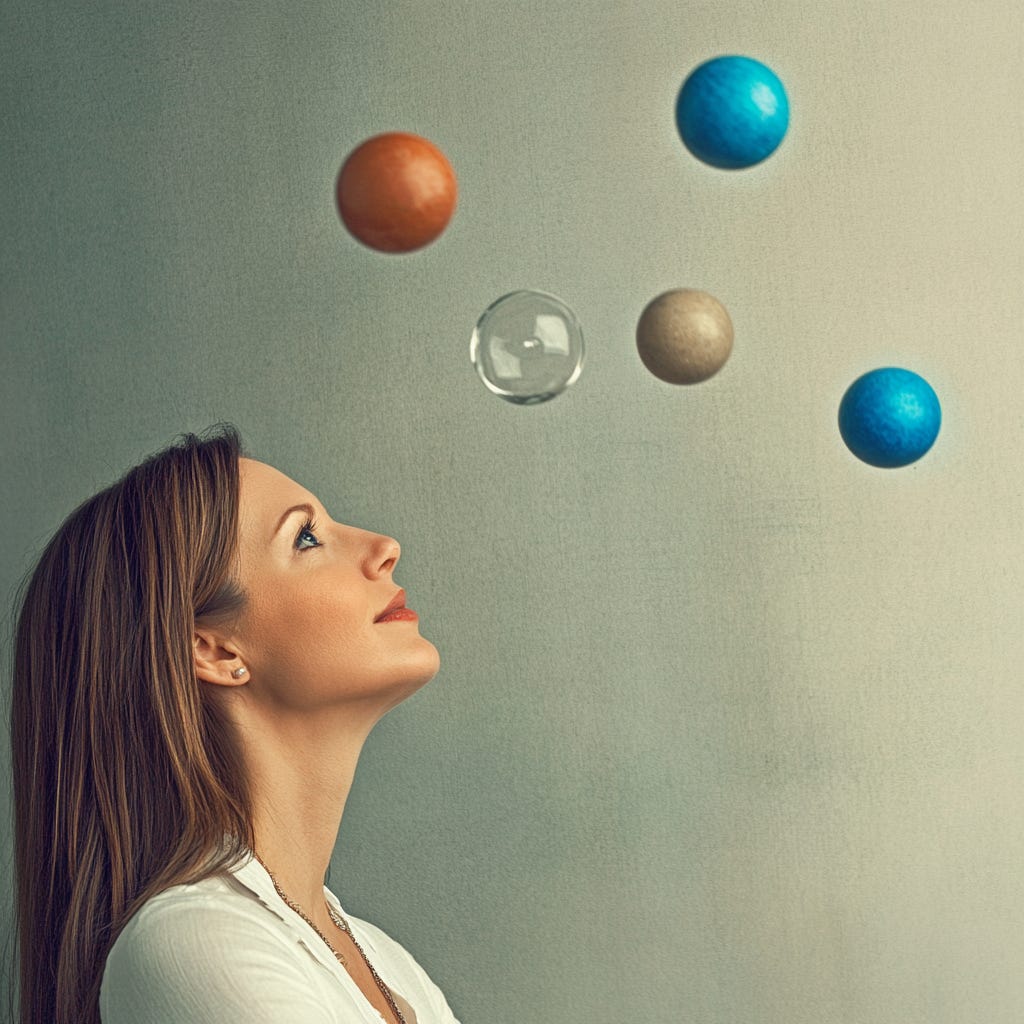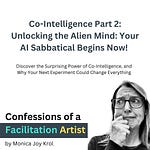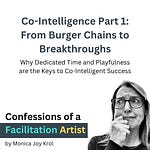I’m back from vacation and have renewed enthusiasm to share new stories and reflections from my journey with AI, creativity, and facilitation. This week, I’m exploring the evolving relationship between humans and AI as creative partners, inspired by Chapter 5 of Ethan Mollick’s “Co-Intelligence: Living and Working with AI.”
Why Talk About AI and Creativity?
As both a facilitator and a product manager, I’m fascinated by how AI is reshaping the creative process, not just for artists and writers, but for anyone who solves problems or builds products. AI is no longer just a tool for automation. It’s becoming a true partner in creativity.
But what does that partnership really look like, and what does it mean for those of us who identify as creative professionals?
Key Insights from “Co-Intelligence” (Chapter 5)
Ethan Mollick opens the chapter with a candid look at large language models (LLMs) and their notorious “hallucinations.” LLMs are fundamentally pattern recognition machines. They don’t actually “know” things, even though they can sound incredibly smart. As Mollick puts it:
“It (LLMs) does not care whether words are true, meaningful or original. It just want to produce a coherent and plausible text that makes you happy.”
This is why LLMs sometimes get things wrong or make up facts. The quality of their output depends heavily on the quality and bias of their source material.
Despite these quirks, LLMs excel at creative tasks, especially writing. But their influence is rapidly expanding into art, music, and video. I’ve found myself watching ads with a new curiosity, wondering which parts are AI-generated and how the psychology of persuasion is evolving in this new era.

Novelty vs. Originality
Mollick draws a distinction between two key concepts:
Novelty: The quality of being new or different, often achieved by creating something not seen before or by combining existing ideas in a fresh way.
Originality: The quality of being independently created or invented, not derived from or imitative of others’ work; marked by fresh and unique ideas.
So who or what does these better? AI or Humans?
Humans excel at originality, creating truly unique, emotionally resonant, and contextually rich work.
AI excels at novelty, rapidly generating many new combinations and ideas, sometimes surpassing humans in quantity and surface-level originality, but lacking depth and genuine uniqueness.
For example, Mollick references creativity tests that are now being applied to AI:
Alternative Uses Test (AUT):
What it is: How many uses can you think of for a common object (e.g., a toothbrush)?
AI’s performance: AI can generate uses at a scale and speed that outperforms most humans. In one study, AI outperformed all but 9.8% of human participants.
Remote Associates Test (RAT):
What it is: Finding common connections between seemingly unrelated words.
AI’s performance: AI also excels at this, often surpassing human performance.

The Enduring Value of Human-Made Work
There’s a real concern that AI could out-invent humans in some areas, and creative jobs may be among the most impacted. But Mollick reframes this, sharing that the best AI output depends on the expertise of the user providing the prompt.
If you have deep knowledge, let’s say, in art history, you can craft a prompt for an image generator like Midjourney that references specific techniques or styles, yielding much richer results than a generic prompt.

This is where I want to bring in a point Simon Sinek recently made on The Diary of a CEO podcast:
“Life is about the journey. But when we think about AI, we only think about the destination. And its remarkable ability to write the book, paint the painting, solve the problem, but we forget the importance of doing the work yourself. And I think in our modern day and age, we have underrepresented the value of struggle. I am smarter, better at problem solving, more resourceful, not because a book exists with my ideas in it, but because I wrote it. That excruciating journey is what made me grow.”
So, as much as AI can generate ideas and mimic creativity, there’s something deeply resonant about the imperfect, sometimes messy, always authentic nature of human creation. That’s what people will seek out and cherish, even as the tools around us get smarter and more polished.
Experimenting with AI Tools: My Cursor Story
Recently, I experimented with Cursor, an AI coding tool, as a non-developer product manager. My goal was to build an OKR (Objectives and Key Results) tracker after our company discontinued a previous tool. Cursor’s chat interface made it surprisingly easy to pick up where I left off, even after a break. I could ask it to walk me through steps, install software, and explain technical concepts in plain English.
This experience highlighted how AI can empower non-experts, but also reinforced the importance of foundational knowledge. My engineering colleagues, with their deeper technical expertise, can leverage these tools even more effectively. The magic of AI is real, but it’s still guided by human context and understanding.
In case you really want to see it, I’m sharing a short video about it below!
What This Means for Product Managers and Creatives
The landscape for product managers and creatives (and pretty much most people) is changing rapidly. Unless you have vertical expertise, deep knowledge in your field, and the motivation to use AI tools daily, you risk being left behind. It’s no longer enough to be generic. The real value comes from knowing your users, your market, and your craft so well that you can communicate requirements, prompts, and shared understanding better than anyone else.
For a deeper dive into this shift, I highly recommend Elena Verna’s Substack post, “The Rise of the AI Native Employee”, which explores how vertical expertise and daily AI fluency are becoming essential for modern roles.
The Facilitation Lens: Divergent and Convergent Thinking with AI
In facilitation and education, we often talk about two modes of thinking:
Divergent Thinking:
Generating lots of ideas, brainstorming and exploring possibilities.
AI’s role: Fantastic partner for divergence. It can help you brainstorm, reframe problems, and even do pre-context research.
Convergent Thinking:
Narrowing down, making decisions, and choosing the best path.
Human’s role: This is where humans shine with judgment, prioritization, and understanding context.
When leading teams or yourself through problem solving, try using AI to:
Reframe problems as “How might we…” statements.
Generate a wide range of solutions.
Cluster or group ideas before moving to decision-making.
But remember: only you and your team can truly weigh the nuances, risks, and cultural factors that AI can’t see.
More Experiments: Vizly and Rapid Prototyping
I’ve also been experimenting with Vizly. Uploading a screenshot of a software product, Vizly instantly created an editable format, a task that used to take me 30 minutes now takes five. I also tried converting a website template into a new site focused on facilitation and AI consulting, complete with playful puns and value props. While it’s not high-fidelity design, it’s perfect for quick edits and communicating ideas with my team or clients.
Closing Reflections
AI is a powerful creative partner, but your expertise, judgment, and context are irreplaceable. If you’re worried about being replaced by AI, focus on deepening your domain knowledge and learning how to use these tools to amplify your strengths.
Next week, I’ll be exploring “AI as a Co-Worker.” Stay tuned for more stories, experiments, and confessions from the front lines of facilitation and AI.















Share this post